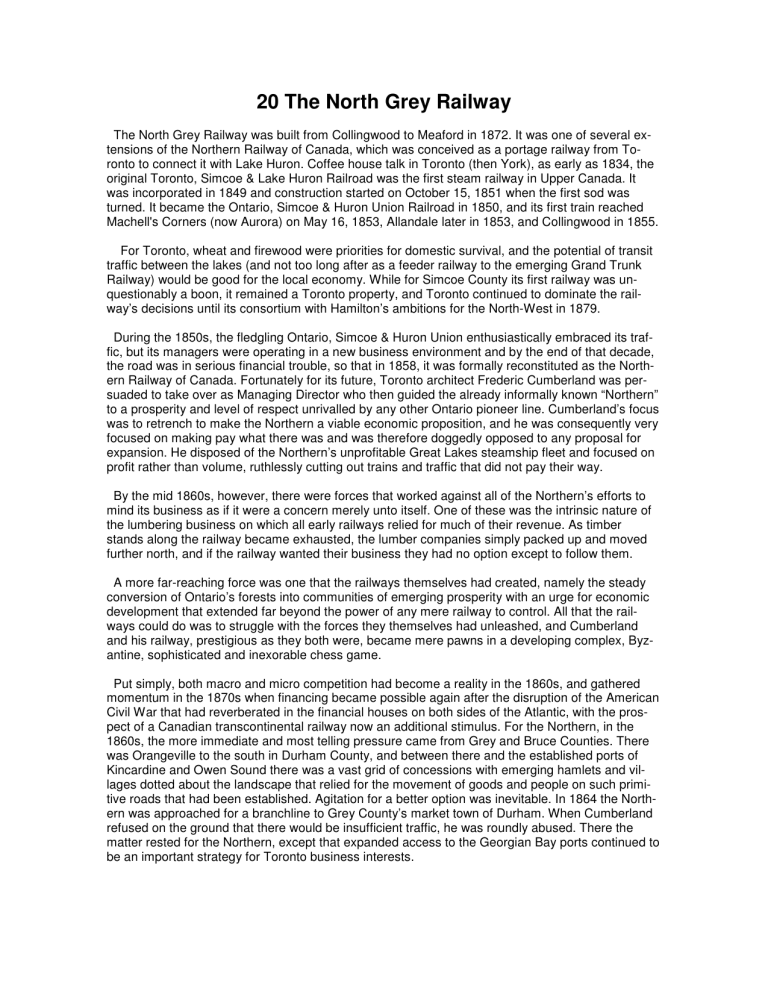
20 The North Grey Railway The North Grey Railway was built from Collingwood to Meaford in 1872. It was one of several extensions of the Northern Railway of Canada, which was conceived as a portage railway from Toronto to connect it with Lake Huron. Coffee house talk in Toronto (then York), as early as 1834, the original Toronto, Simcoe & Lake Huron Railroad was the first steam railway in Upper Canada. It was incorporated in 1849 and construction started on October 15, 1851 when the first sod was turned. It became the Ontario, Simcoe & Huron Union Railroad in 1850, and its first train reached Machell's Corners (now Aurora) on May 16, 1853, Allandale later in 1853, and Collingwood in 1855. For Toronto, wheat and firewood were priorities for domestic survival, and the potential of transit traffic between the lakes (and not too long after as a feeder railway to the emerging Grand Trunk Railway) would be good for the local economy. While for Simcoe County its first railway was unquestionably a boon, it remained a Toronto property, and Toronto continued to dominate the railway’s decisions until its consortium with Hamilton’s ambitions for the North-West in 1879. During the 1850s, the fledgling Ontario, Simcoe & Huron Union enthusiastically embraced its traffic, but its managers were operating in a new business environment and by the end of that decade, the road was in serious financial trouble, so that in 1858, it was formally reconstituted as the Northern Railway of Canada. Fortunately for its future, Toronto architect Frederic Cumberland was persuaded to take over as Managing Director who then guided the already informally known “Northern” to a prosperity and level of respect unrivalled by any other Ontario pioneer line. Cumberland’s focus was to retrench to make the Northern a viable economic proposition, and he was consequently very focused on making pay what there was and was therefore doggedly opposed to any proposal for expansion. He disposed of the Northern’s unprofitable Great Lakes steamship fleet and focused on profit rather than volume, ruthlessly cutting out trains and traffic that did not pay their way. By the mid 1860s, however, there were forces that worked against all of the Northern’s efforts to mind its business as if it were a concern merely unto itself. One of these was the intrinsic nature of the lumbering business on which all early railways relied for much of their revenue. As timber stands along the railway became exhausted, the lumber companies simply packed up and moved further north, and if the railway wanted their business they had no option except to follow them. A more far-reaching force was one that the railways themselves had created, namely the steady conversion of Ontario’s forests into communities of emerging prosperity with an urge for economic development that extended far beyond the power of any mere railway to control. All that the railways could do was to struggle with the forces they themselves had unleashed, and Cumberland and his railway, prestigious as they both were, became mere pawns in a developing complex, Byzantine, sophisticated and inexorable chess game. Put simply, both macro and micro competition had become a reality in the 1860s, and gathered momentum in the 1870s when financing became possible again after the disruption of the American Civil War that had reverberated in the financial houses on both sides of the Atlantic, with the prospect of a Canadian transcontinental railway now an additional stimulus. For the Northern, in the 1860s, the more immediate and most telling pressure came from Grey and Bruce Counties. There was Orangeville to the south in Durham County, and between there and the established ports of Kincardine and Owen Sound there was a vast grid of concessions with emerging hamlets and villages dotted about the landscape that relied for the movement of goods and people on such primitive roads that had been established. Agitation for a better option was inevitable. In 1864 the Northern was approached for a branchline to Grey County’s market town of Durham. When Cumberland refused on the ground that there would be insufficient traffic, he was roundly abused. There the matter rested for the Northern, except that expanded access to the Georgian Bay ports continued to be an important strategy for Toronto business interests. 2 As far as local railways were concerned, the Northern still had a monopoly there, and needless to say, whenever there is a monopoly, there is dissatisfaction. The Northern had been born amid controversy, and the fact that it had the monopoly on firewood in Toronto was a major immediate issue, as in those days, firewood had the importance that oil and hydro do today. The Toronto distillery of Gooderham & Worts proved to have a key influence in the railway politics of the day. They had hired a wheat buyer by the name of George Laidlaw. The distillery not only needed firewood, but grain to feed its stills. Laidlaw persuaded his employers to underwrite two narrow gauge lines, one to the north east to Uxbridge and beyond, and one to the north west with the primary target of Owen Sound. In short, the Toronto, Grey & Bruce Railway was incorporated in 1868, work began the following spring, and this railway reached Owen Sound in 1873. Faced with this pressure, on February 15, 1871 the Northern gave its blessing to the incorporation of the North Grey Railway to build from Collingwood to Meaford, with authority to extend to Owen Sound. The citizens of Grey County backed the railway financially with great enthusiasm, and the intended first section to Meaford was opened for traffic on April 1, 1872. So why did the line never reach Owen Sound? The reasons are open to speculation, but the following are undoubtedly the main factors: 1. The completion of the narrow-gauge Toronto, Grey & Bruce to Owen Sound in 1873. 2. Financing. The municipal bonuses (subsidies) for the construction of the second section would have had to have come from Owen Sound and Sydenham Township, both unlikely prospects considering that Owen Sound now already had a direct rail connection, and there would be little interest in a trip to Toronto via Collingwood and Barrie. 3. Terrain. The stretch between Collingwood and Meaford had been easy engineering, but the section to Owen Sound would have had to deal with the steady gradient out of Meaford. 4. The Northern had to contend with considerable agitation for another two projects closer to its main axis of operation. One was a from very influential Toronto consortium that was pushing for the extension of the Northern from Barrie through to Orillia, which resulted in the incorporation in late 1869 of the Toronto, Simcoe & Muskoka Junction Railway to build from Barrie to Orillia and beyond to a terminal on Lake Muskoka. The other project was the North Simcoe Railway, promoted at the same time by both Toronto and Simcoe County interests to tap the timber resources in the heart of Simcoe County. Thus its construction followed suit in 1880, along with the Flos Tramway to bring out the lumber from Hillsdale. 5. Last, but by no means least, in the 1870s the Northern was facing real competition in Simcoe County from Hamilton and its Hamilton & North Western Railway that was to cut a swath through the heart of Simcoe County on its planned way to Canada’s North West, and the Northern found itself in a tariff war in order to save its business. On all of these counts, the originally-planned extension to Owen Sound became irrelevant in a struggle to survive, compete, and expand to the north. The Northern and the Hamilton North Western arrived at a joint management agreement in 1879, to form the Northern & North Western Railways, which extended its network to North Bay to connect up with the transcontinental railway by means of its subsidiary Northern & Pacific Junction Railway, but came under the increasing influence of the Grand Trunk Railway who absorbed the Northern & North Western in 1888, and in turn became part of the Canadian National Railways system in 1923. Regular passenger service ceased on the Meaford branch in 1960, and it was abandoned in 1985. © Charles Cooper. All rights reserved. 10-09



